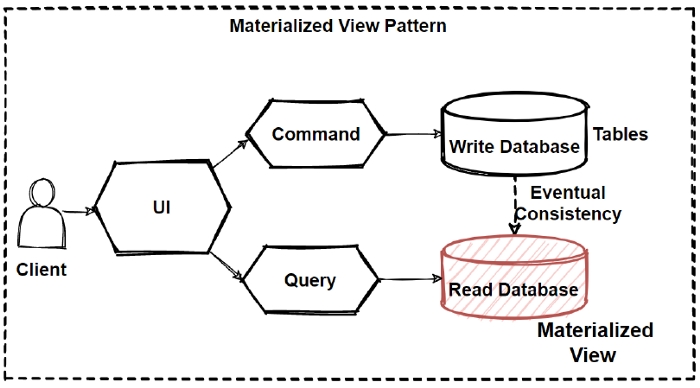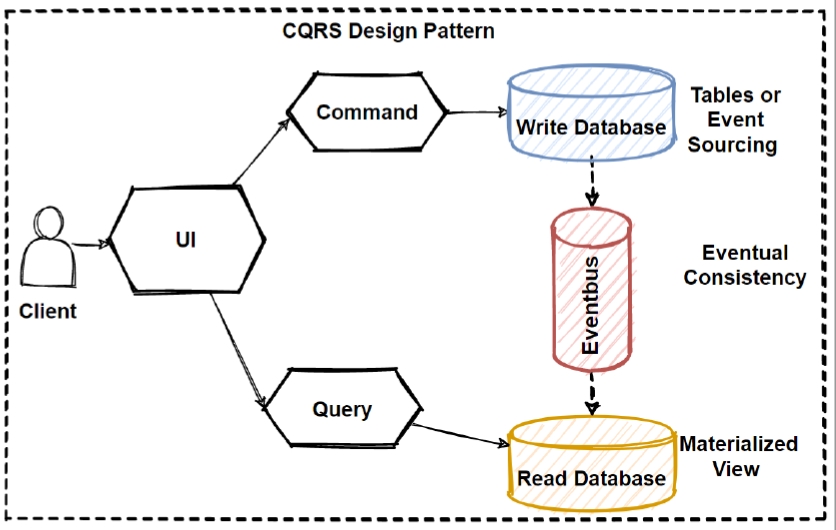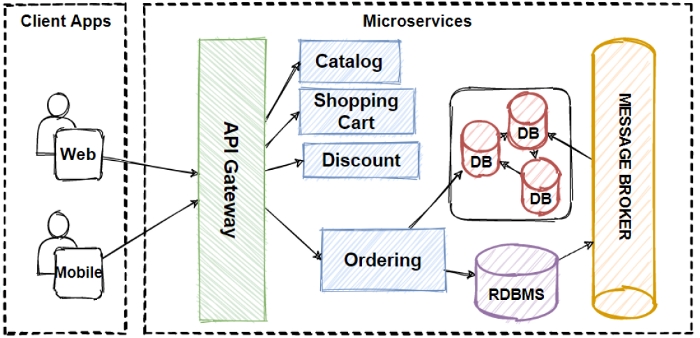CQRS (Command and Query Responsibility Segregation)
CQRS stands for Command and Query Responsibility Segregation, a pattern that separates read and update operations for a data store. Implementing CQRS in your application can maximize its performance, scalability, and security. The flexibility created by migrating to CQRS allows a system to better evolve over time and prevents update commands from causing merge conflicts at the domain level.
Normally, in monolithic applications, most of time we have 1 database and this database should respond both query and update operations. That means a database is both working for complex join queries, and also perform CRUD operations. But if the application goes more complex this query and crud operations will be also is going to be un-manageable situation.
In example of reading database, if your application required some query that needs to join more than 10 table, this will lock the database due to latency of query computation. Also if we give example of writing database, when performing crud operations we would need to make complex validations and process long business logics, so this will cause to lock database operations.

So reading and writing database has different approaches that we can define different strategy to handle that operation. In order to that CQRS offers to use “separation of concerns” principles and separate reading database and the writing database with 2 database. By this way we can even use different database for reading and writing database types like using no-sql for reading and using relational database for crud operations.
Another consideration is we should understand our application use case behaviors, if our application is mostly reading use cases and not writing so much, we can say our application is read-incentive application. So we should design our architecture as per our reading requirements with focusing reading databases.
So we can say that CQRS separates reads and writes into different databases, Commands performs update data, Queries performs read data.
Commands should be actions with task-based operations like “add item into shopping cart” or “checkout order”. So commands can be handle with message broker systems that provide to process commands in async way.
Queries is never modify the database. Queries always return the JSON data with DTO objects. By this way, we can isolate the Commands and Queries.
In order isolate Commands and Queries, its best practices to separate read and write database with 2 database physically. By this way, if our application is read-intensive that means reading more than writing, we can define custom data schema to optimized for queries.
Materialized view pattern is good example to implement reading databases. Because by this way we can avoid complex joins and mappings with pre defined fine-grained data for query operations.

By this isolation, we can even use different database for reading and writing database types like using no-sql document database for reading and using relational database for crud operations.
Instagram Database Architecture
This is so popular on microservices architecture also let me give an example of Instagram architecture. Instagram basically uses two database systems, one is relational database PostgreSQL and the other is no-sql database — Cassandra.

So that means Instagram uses no-sql Cassandra database for user stories that is read-incentive data. And using relational PostgreSQL database for User Information bio update. This is one of the example of CRQS approaches.
How to Sync Databases with CQRS ?
But when we separate read and write databases in 2 different database, the main consideration is sync these two database in a proper way.
So we should sync these 2 databases and keep sync always.
This can be solve by using Event-Driven Architecture. According to Event Driven Architecture, when something update in write database, it will publish an update event with using message broker systems and this will consume by the read database and sync data according to latest changes.
But this solution creates a consistency issue, because since we have implemented async communication with message brokers, the data would not be reflected immediately.

This will operates the principle of “eventual consistency”. The read database eventually synchronizes with the write database, and it can be take some time to update read database in the async process. We discuss eventual consistency in the next sections.
So if we come back to our read and write databases in CQRS pattern, When starting your design, you can take read database from replicas of write database. By this way we can use different read-only replicas with applying Materialized view pattern can significantly increase query performance.
Also when we separated read and write databases, it means we can scale them independently. That means if our application is read-incentive, I mean if it much more query that write, than we can scale only reading databases very fast.
CQRS comes with separating commands and query databases. So this required to sync both 2 databases with offering event-driven architectures. And with Event-driven architectures there are some new patterns and practices should be consider when applying CQRS.
Event Sourcing pattern is the first pattern we should consider to use with CQRS. Mostly CQRS is using with “Event Sourcing pattern” in Event-Driven Architectures. So after we have learned the CQRS we should learn “Event Sourcing pattern”, because CQRS and “Event Sourcing pattern” is the best practice to use both of them.
Design the Architecture — CQRS, Event Sourcing, Eventual Consistency, Materialized View
We are going to Design our e-commerce Architecture with applying CQRS Pattern.

Now We can Design our Ordering microservices databases
I am going to split 2 databases for Ordering microservices 1 for the write database for relational concerns 2 for the read database for querying concerns
So when user create or update an order, I am going to use relational write database, and when user query order or order history, I am going to use no-sql read database. and make consistent them when syncing 2 databases with using message broker system with applying publish/subscribe pattern.
Now we can consider tech stack of these databases,
I am going to use SQL Server for relational writing database, and using Cassandra for no-sql read database. Of course we will use Kafka for syncing these 2 database with pub/sub Kafka topic exchanges.
So we should evolve our architecture with applying other Microservices Data Patterns in order to accommodate business adaptations faster time-to-market and handle larger requests.
Last updated